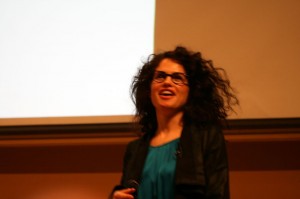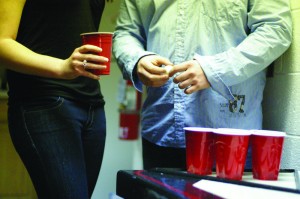By Meghan Finlayson
Writer
The recent rash of sexual assault and violence cases on campus has motivated many members of the University community to take action. “Take Back the Night” (A March for a Better Bucknell) and the Movement4Manner are among the responses.
More than 400 students, faculty, staff and community members marched in Take Back the Night, a walk to raise awareness about violence on campus last Saturday. The walk began on the Smith Quad and concluded with food and refreshments on the Academic Quad.
Take Back the Night was sponsored by the Women’s Resource Center, Bucknell Student Government (BSG) and students from V-Day Bucknell.
The event received support from the Events Office, Facilities, Dining Services, Performance Services, Bucknell Public Safety and the Lewisburg Police Department.
“Students worked very hard to encourage participation in the march and helped create an event to unite the Bucknell community around these important issues,” said Tracy Shaynak, sexual assault survivor advocate response coordinator.
Some students believed the large turnout was a positive step in the battle to end violence on campus.
“The walk around downtown was beautiful, and something that I will never forget. It was one of those nights that made me proud to be a Bucknellian,” Michael Davis ’13 said.
Take Back the Night is a foundation that takes a stand against sexual violence, and Take Back the Night rallies began in Philadelphia in 1975, according to the foundation’s website.
“The idea behind having a Take Back the Night march at Bucknell is one of taking a stand against injustice. The fact is that at colleges across the U.S., female students face a much higher rate of sexually motivated violence than men, and even women outside of college,” Alexandre Apfel ’12 said. “Given the recent upswing in campus violence in general, having the march helps to build awareness and show a physical presence here on campus that wants the violence to stop.”
The walk was part of a continuing effort to unite the University community and demonstrate that many students, faculty and staff are dedicated to supporting a safe and respectful campus environment, Shaynak said.
“We encourage students to consider becoming a peer educator, to join a student organization directly involved in addressing these issues and to be willing to talk about these issues with their friends and on their residence hall floors,” she said.
Davis, a resident assistant on campus, created the Facebook group entitled “Movement4Manner” to promote respect for community members.
Though Movement4Manner is not directly involved in Take Back the Night, it also joins the fight against sexual violence and disrespect.
“M4M started after myself, my fellow McDonnell RAs and our Assistant Director Rachael Gebely were in a meeting discussing some of the violent events that have taken place on campus. For weeks, I had heard various stories of fights, attacks and sexual assaults taking place, and had considered doing something about,” Davis said.
Davis called M4M an “active petition.” The group stands for a safe campus, both physically and emotionally.
“These things are very basic, but there is a small number of students who seem to have forgotten some of these things,” Davis said.
Apfel, another member of M4M said that the point of the movement is to generate conversation.
“The more people think and talk about it, the more likely it is they’ll think about how they’re acting,” said Apfel, another member of M4M.
Davis believes that M4M has the potential to grow over time.
“I’m really looking for other students who are also concerned about what’s been happening on our campus to help define what the future will be. This movement is not mine, it’s Bucknell’s. What happens with it is largely dependent upon what we, the students, want to do with it,” Davis said.
INFO BOX
Initiatives to combat sexual assault and violence
SATF—Provost Mick Smyer announced that the final report of the Sexual Assault Task Force (SATF) is now available on Blackboard in an e-mail dated Oct. 25. The group was formed in the fall of 2006 to review policies and adjudication, support services and education and prevention related to sexual assault on campus.
Campus Climate Task Force—President John Bravman announced the formation of a Campus Climate Task Force in an e-mail dated Oct. 20. Chaired by George Shields, Dean of the College of Arts & Sciences, and Beth Capaldi Evans, associate professor of biology, the group will evaluate the campus climate, including how students view and act upon their responsibilities to the University and to each other.
IFC Declaration—The InterFraternity Council issued a “Declaration Denouncing Sexual Assault” calling for a “zero tolerance” policy.


